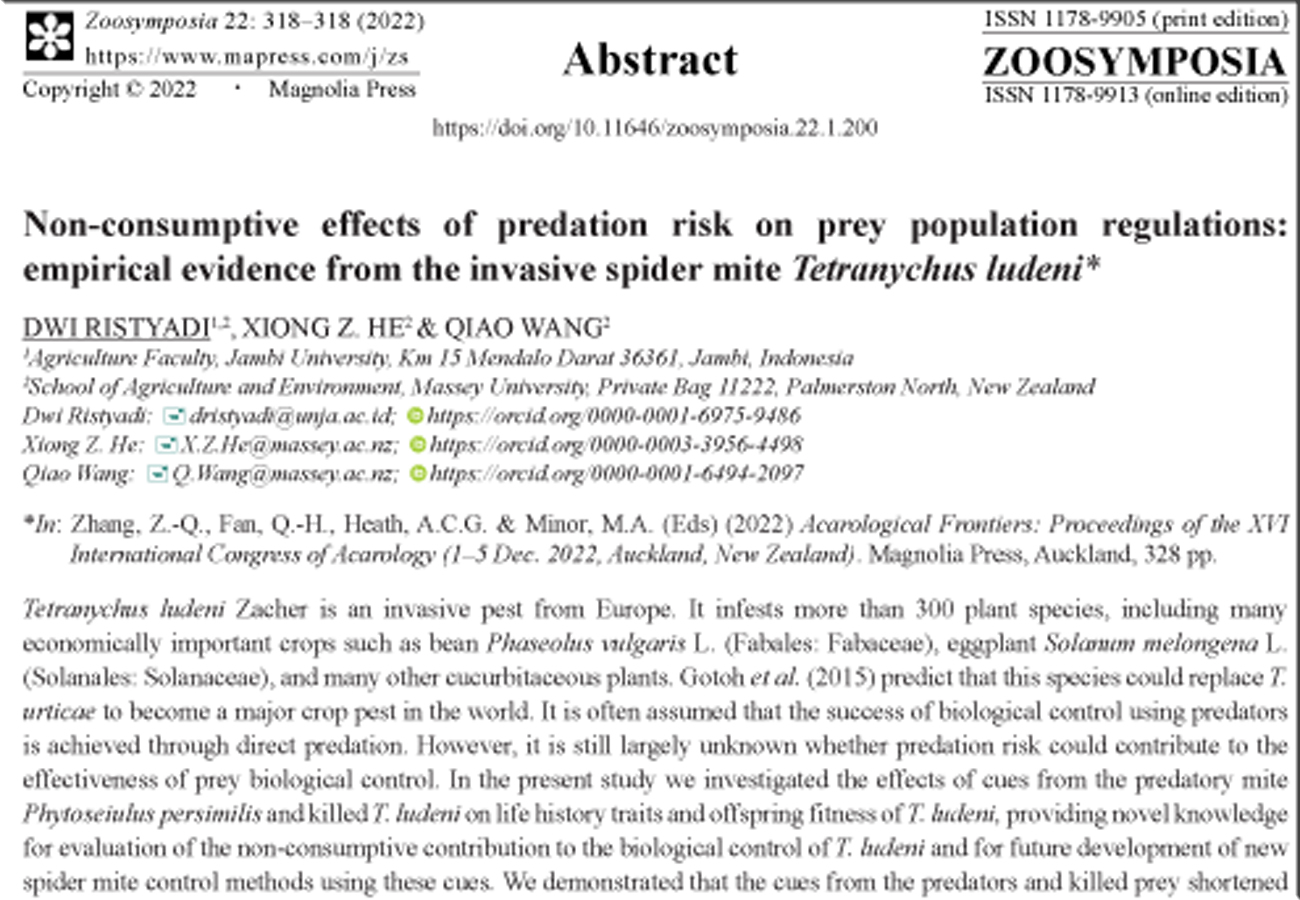Abstract
Tetranychus ludeni Zacher is an invasive pest from Europe. It infests more than 300 plant species, including many economically important crops such as bean Phaseolus vulgaris L. (Fabales: Fabaceae), eggplant Solanum melongena L. (Solanales: Solanaceae), and many other cucurbitaceous plants. Gotoh et al. (2015) predict that this species could replace T. urticae to become a major crop pest in the world. It is often assumed that the success of biological control using predators is achieved through direct predation. However, it is still largely unknown whether predation risk could contribute to the effectiveness of prey biological control. In the present study we investigated the effects of cues from the predatory mite Phytoseiulus persimilis and killed T. ludeni on life history traits and offspring fitness of T. ludeni, providing novel knowledge for evaluation of the non-consumptive contribution to the biological control of T. ludeni and for future development of new spider mite control methods using these cues. We demonstrated that the cues from the predators and killed prey shortened the longevity by more than 23% and oviposition period by more than 35% and reduced the number of eggs laid by more than 31% in T. ludeni females. These cues also significantly reduced the intrinsic rate of increase and net population growth rate and prolonged the time to double the population size. Furthermore, in response to predator cues females significantly delayed their lifetime production of daughters and laid significantly smaller eggs. Offspring from predator-exposed mothers developed significantly more slowly. Our findings strongly suggest that the non-consumptive mortality caused by cues from both predators and killed prey can significantly reduce prey fitness, suppressing their population and lowering their damage to crops. The earlier prey death caused by these cues could result from the energic costs of natural enemy avoidance (Luong et al. 2017), decrease of foraging rate or food intake (Hermann & Thaler 2014) and increase of oxidative damage (Janssens & Stoks 2013). The present study partially supports previous reports that non-consumptive impacts of predation risk on prey are transgenerational (Tariel et al. 2020). Our study provides critical information for evaluation of biological control effectiveness using predators and paves the way for identification of chemical odors from the predator and killed prey and development of new materials and methods for the control of spider mite pests.
References
Gotoh, T., Moriya, D. & Nachman, G. (2015) Development and reproduction of five Tetranychus species (Acari: Tetranychidae): Do they all have the potential to become major pests? Experimental and Applied Acarology, 66, 453–479. https://doi.org/10.1007/s10493-015-9919-y
Hermann, S.L. & Thaler, J.S. (2014) Prey perception of predation risk: volatile chemical cues mediate non-consumptive effects of a predator on a herbivorous insect. Oecologia, 176, 669–676. https://doi.org/10.1007/s00442-014-3069-5
Janssens, L. & Stoks, R. (2013) Predation risk causes oxidative damage in prey. Biology Letters, 9, 1–4. https://doi.org/10.1098/rsbl.2013.0350
Luong, L.T., Horn, C.J. & Brophy, T. (2017) Mitey costly: energetic costs of parasite avoidance and infection. Physiological and Biochemical Zoology, 90, 471–477. https://doi.org/10.1086/691704
Tariel, J., Plénet, S. & Luquet, É. (2020) Transgenerational plasticity in the context of predator-prey interactions. Frontier in Ecology and Evolution, 8, 548660. https://doi.org/10.3389/fevo.2020.548660


